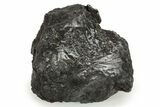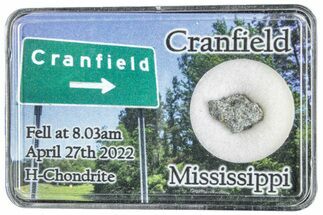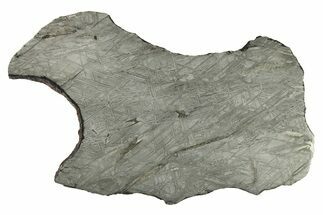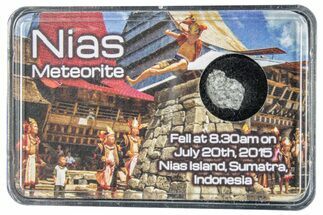This Specimen has been sold.
2.8" Nantan (Nandan) Iron-Nickel Meteorite (467.2 g) - China
This is a 2.8" wide (467.2 grams) meteorite of the iron-nickel (IAB) Nantan (Nandan) meteor, collected from the strewn field near the city of Nantan within the Guagxi Region of China. The meteorite has been stabilized and sealed to prevent rusting.
The Nantan Meteorite
The Nantan (also Nandan) meteorite is a main-group iron-nickel (IAB) meteorite discovered near the city of Nantan in the Guagxi region of southern China. Based on surviving records its fall may have been observed in 1516: a surviving account recalls that “during summertime in May of Jiajing 11th year, stars fell from the northwest direction, five to six fold long, waving like snakes and dragons. They were as bright as lightning and disappeared in seconds". Fragments in its 28-kilometer strewn field were not discovered until the 1950s, when locals began gathering pieces of it for smelting as China pushed to industrialize. Since its discovery, almost 10 metric tons of material have been recovered. The main mass is displayed at the National Museum of Nature and Science in Tokyo, Japan.
When cleaned, samples of this meteorite display beautiful, three-dimensional Widmanstätten lines and large troilite nodules. Many pieces have a rich bronze patina on their exteriors.
The Nantan (also Nandan) meteorite is a main-group iron-nickel (IAB) meteorite discovered near the city of Nantan in the Guagxi region of southern China. Based on surviving records its fall may have been observed in 1516: a surviving account recalls that “during summertime in May of Jiajing 11th year, stars fell from the northwest direction, five to six fold long, waving like snakes and dragons. They were as bright as lightning and disappeared in seconds". Fragments in its 28-kilometer strewn field were not discovered until the 1950s, when locals began gathering pieces of it for smelting as China pushed to industrialize. Since its discovery, almost 10 metric tons of material have been recovered. The main mass is displayed at the National Museum of Nature and Science in Tokyo, Japan.
When cleaned, samples of this meteorite display beautiful, three-dimensional Widmanstätten lines and large troilite nodules. Many pieces have a rich bronze patina on their exteriors.
About Iron Meteorites
Iron type meteorites are composed primarily of iron and nickel, and are the remnants of differential cores torn apart at the beginning of the solar system. These metallic meteorites are often the easiest to identify after millions of years post-impact because they are quite different from terrestrial material, especially when it comes to their mass-to-surface area ratio. They are exceptionally heavy for their size since iron is a high-density metal: this is also why the Earth's core is nickel-iron. As planets form, the densest metals form gravitational centers, bringing more and more material into their gravitational pull. In the solar system's rocky planets, these dense materials are most often nickel and iron.
Most iron meteorites have distinctive, geometric patterns called Widmanstätten patterns, which become visible when the meteorite is cut and acid etched. These patterns are criss-crossing bands of the iron-nickel alloys kamacite and taenite that slowly crystalized as the core of the meteorites' parent bodies slowly cooled. Such large alloy crystallizations for mover millions of years and do not occur naturally on Earth, further proving that iron meteorites come from extraterrestrial bodies.
Iron type meteorites are composed primarily of iron and nickel, and are the remnants of differential cores torn apart at the beginning of the solar system. These metallic meteorites are often the easiest to identify after millions of years post-impact because they are quite different from terrestrial material, especially when it comes to their mass-to-surface area ratio. They are exceptionally heavy for their size since iron is a high-density metal: this is also why the Earth's core is nickel-iron. As planets form, the densest metals form gravitational centers, bringing more and more material into their gravitational pull. In the solar system's rocky planets, these dense materials are most often nickel and iron.
Most iron meteorites have distinctive, geometric patterns called Widmanstätten patterns, which become visible when the meteorite is cut and acid etched. These patterns are criss-crossing bands of the iron-nickel alloys kamacite and taenite that slowly crystalized as the core of the meteorites' parent bodies slowly cooled. Such large alloy crystallizations for mover millions of years and do not occur naturally on Earth, further proving that iron meteorites come from extraterrestrial bodies.
TYPE
Iron-Nickel (IAB)
LOCATION
Near Nantan, Guagxi Region, China
SIZE
Size: 2.8 x 2.55 x 1.7", Weight: 467.2 grams
CATEGORY
SUB CATEGORY
ITEM
#277455
 Reviews
Reviews














